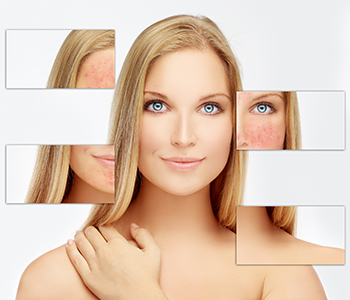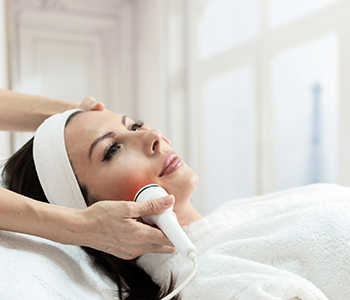Algonquin dermatologist avoids side effects of laser treatment for rosacea, so healthy skin shines through
Posted by Dr. Vikram Khanna
- Burns
- Blistering
- Scars
- Discoloration
Procedures you can trust
 Laser or light therapy is frequently combined with other common treatments, such as prescription topical creams. Following a consultation and thorough skin and medical evaluation, Dr. Khanna is likely to recommend light-based treatments if your rosacea is characterized by visible blood vessels, or extensive redness. Of the four “subtypes,” patients who have either erythematotelangiectatic or papulopustular rosacea are most likely to be candidates for light-based procedures. These subtypes include red discoloration, flushing, visible blood vessels, redness, swelling, and breakouts that resemble acne.
Laser or light therapy is frequently combined with other common treatments, such as prescription topical creams. Following a consultation and thorough skin and medical evaluation, Dr. Khanna is likely to recommend light-based treatments if your rosacea is characterized by visible blood vessels, or extensive redness. Of the four “subtypes,” patients who have either erythematotelangiectatic or papulopustular rosacea are most likely to be candidates for light-based procedures. These subtypes include red discoloration, flushing, visible blood vessels, redness, swelling, and breakouts that resemble acne.
Dr. Khanna may also recommend laser resurfacing with fractional ablative CO2 to treat the thickening or disfigurement caused by phymatous rosacea, which is associated with a rough, bumpy texture. The dryness, burning, swelling, and tearing of ocular rosacea may be controlled with prescription medications including oral antibiotics instead of procedures.
When light procedures are recommended
As a treatment for symptoms of rosacea, Dr. Khanna uses a laser or IPL device to direct wavelengths to blood vessels underneath the skin. The heat produced by the laser’s energy builds up in those vessels, safely destroying them. These devices can also be used to address the buildup of excess tissue inherent with phymatous rosacea, but laser resurfacing procedures may be more appropriate to remove excess tissue and to reshape the nose, an area frequently affected by this condition.The newest devices are designed to minimize the risk of some of the most common side effects from light-based procedures, which include:
- Pinkness or redness
- Swelling
- Purple or red spotting
- Tight, itchy sensation
Low-risk, yet no less powerful
 When advanced technologies and surgical skill meet, you don’t have to go through pain to see and feel dramatic gains. Most patients saw a 75 to 90% reduction in visible blood vessels after one to two treatment sessions spaced four weeks apart. Some patients completely cleared their rosacea symptoms.
When advanced technologies and surgical skill meet, you don’t have to go through pain to see and feel dramatic gains. Most patients saw a 75 to 90% reduction in visible blood vessels after one to two treatment sessions spaced four weeks apart. Some patients completely cleared their rosacea symptoms.
Thickening may also be treated, but the earlier you can address excess tissue, the easier it is to treat. Results often last about five years, and treated vessels don’t reappear. But new vessels can become visible, so it’s important to take any medications as advised and to complete follow-up treatment sessions to maintain beautiful results. A cornerstone of long-term skin health includes adhering to a proper skin care regimen built around your rosacea subtype and unique characteristics. It’s also important to identify lifestyle or environmental triggers to avoid flare-ups. The National Rosacea Society reports the most common triggers among 1,066 rosacea patients surveyed included, in order of prevalence:
- Sun exposure
- Stress
- Heat
- Wind
- Strenuous exercise
- Alcohol
- Hot baths
- Cold
- Spicy foods





















